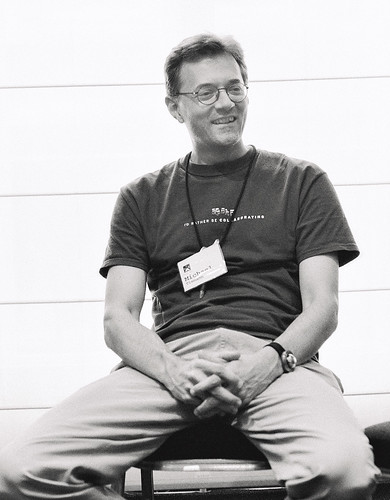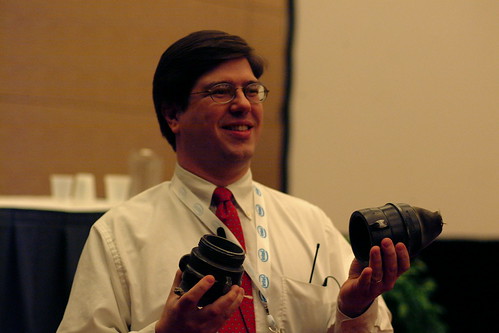OpenOffice.org Conference 2007: some thoughts
The OpenOffice.org Conference 2007 was held in Barcelona, from the 19th to the 21th of September. People from all the world, employees and volunteers, attended the conference to learn about OpenOffice.org future.
I returned myself a couple of days ago, and I wish to share here some thoughts about the final round table, actually one of the most important sessions.
Round table participants were:
- Louis Suarez-Potts, OpenOffice.org Community manager, who recently joined Sun Microsystems;
. - Zaheda Bhorat, managing Open Source Programs at Google (formerly working at Sun),
. - John McCreesh volunteer and OOo marketing Project leader;
. - a representative of IBM (sorry, I don’t remember the name);
. - Michael Bemmer, StarOffice manager at Sun Microsystems;
. - Simon Phipps – Chief Open Source Officer at Sun Microsystems;
. - Michael Meeks from Novell;
. - Cai Yung Hu from RedFlag.
While I was expecting to hear some news about the future of the project, the panel was basically a self celebrating presentation focused on download results and on the new project entries, namely IBM and RedFlag RedFlag.
Now, unless we redefine a community just as a technological club open to firms, I wouldn’t call this group a community. After IBM and RedFlag joined the project, it is getting more and more difficult to call OOo an Open Source project managed by the community. it is becoming an Open Source project managed by big companies, “build contributed in collaboration with the community“.
Barcelona guested also the Drupal Conference over those days, and it is worth to mention. Drupal is a CMS (Content Management System) released with GPL license and managed by a community. More than 400 people attended this conference, they paid 50 Euro, they mainly represented themselves or small firms and there were more than 40 sponsors.
On the other hand, about 300 people attended the OOoConf without paying any fee, and only few people came from small firms or just for personal interest. Many were from Sun and Novell and sponsors were less than 15.
Drupal and OOo are not comparable in term of code and users. There are different orders of magnitude between them. Nevertheless Drupal has more participation than OOo. Frankly I’d expect much more community participation from the biggest Open Source project in the world. Inside OOo I would like to view more hybridization among stake holders and the community . This would allow a better participation of single volunteers and small firms that are at the moment quite scarse. Louis said the next 12 months will be the most important of the entire project history. I definitively agree. And I hope they will be spent to make it really open because without a community the future is at risk.
What is your opinion?

 Prevent..by
Prevent..by  Michael Tiemann by
Michael Tiemann by  Game (almost) Over by
Game (almost) Over by  David Wheeler by
David Wheeler by  Good will by
Good will by  Recursion by
Recursion by  Life is a Juggling act by
Life is a Juggling act by 
 Florian Mueller by
Florian Mueller by
Simon Phipps 11:31 am on October 2, 2007 Permalink
I didn’t think much of that panel either, David, but I think you need to reflect more deeply. A key question to ask is how many of the people at the Drupal event were actually developers working on the core code, and how many were end users?
OOoCon had a large proportion of people who were directly involved in co-development of OpenOffice.org – the annual OOoCon provides them with a place to meet. OO.o is well sponsored, yes, which some people regard as a strength. Thus most of the individual developers who work on its code are employees of a sponsor company. End users of OpenOffice.org don’t really have to have special skills to use it so aren’t that motivated to attend. There are many end-user mini-conferences around the world during the year, arranged by the excellent OOo marketing community.
By contrast, Drupal users will be mainly programmers and/or SysAdmins. They will be interested in hints and tips on usage, on meeting each other for learning and support. Drupal is also relatively new and there are plenty of people encountering it for the first time. I’d expect a Drupal event to be larger and to have a larger number of users attending.
While I think the discussion of community building is a good think (indeed there was a session on that topic at OOoCon), I think your comparison is misplaced. Any technology whose main users are developers will produce the effect you describe when compared against OOo, regardless of the health of either community.
Michael Meeks 11:24 am on October 3, 2007 Permalink
Unfortunately, attracting and retaining corporate developers to work on OO.o is really rather a difficult problem, though easier than attracting volunteers 🙂 Persuading Sun to change their community and ownership structures to improve things is also an almost impossible task.
Some day, I hope we’ll see a meritocratically elected board of core contributors rounding up an OO.o conference packed with developers 🙂
Simon Phipps 5:09 pm on October 3, 2007 Permalink
Has it been easier for Ximian Evolution, Michael?
JJS 6:47 pm on October 3, 2007 Permalink
A community is what it is. Those who are interested in the project will join and participate based on their level of interest. Those who do not participate can offer opinions. But if the opinion simply amounts to, “I don’t like your community,” then the project members are likewise free to offer constructive criticism on that opinion.
Later . . . Jim
Tor Lillqvist 11:02 am on October 5, 2007 Permalink
Aren’t you linking to the wrong Red Flag company? The one that joined the OOo community is called something like “Red Flag CH2000” http://wiki.services.openoffice.org/wiki/Beijing_Redflag_Chinese_2000_Software_Co.,_Ltd.(, while you link to Red Flag Linux, another entity http://en.wikipedia.org/wiki/Red_Flag_Linux
Davide Dozza 11:22 am on October 5, 2007 Permalink
Simon, I definitively agree with you about developers and end-users. But this is exactly the question a I’m reflecting on.
Why OOocon had a large proportion of people who were directly involved in co-development of OpenOffice.org and they come almost from Sun, IBM, etc and not from small and medium firms?
I think OOo could be a great horizontal framework for services and software delivery on which firms could develop their business and contribute back. And moreover OOo could also be a place where volunteers contribute or a gym for people who want to get trained in a large and challenging project.
But OOo doesn’t look like this. It seems that the major discussion topics are relating to keep satisfied the SUN requirements which are JCA, license, etc. instead to encourage external contributions and participation.
It’s maybe time to transform StarDivision people from great developers to project managers oriented to the Community and to open the project?
Davide Dozza 11:36 am on October 5, 2007 Permalink
Jim, first we have to define what kind of community we are talking about. Is it a free software community? Is it a software user community? Is it a community of software vendors? I think is very important because people can get puzzled about, as I’m becoming.
In this way people will consciously join and participate to the project.
Roberto Galoppini 4:08 pm on October 5, 2007 Permalink
You’re definitely right Tor, thank you!
Simon Phipps 10:50 pm on October 5, 2007 Permalink
I just wrote a huge long answer and WP threw it away. Too upset to write it again, maybe next week.